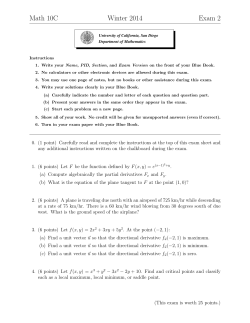
HW8 - UCLA
Math 32B Steven Heilman Digest 8 (A compilation of emailed homework questions, answered around Wednesday.) Question. (From a student): Question 3 includes the statement “curlF (x, y) = 1”. This seems to be setting a vector equal to a scalar. How is this possible, or what vector does the “1” represent? Answer. If we have a vector field F : R3 → R3 , then curl(F ) is indeed a vector in R3 . However, if we have a vector field F : R2 → R2 , then we defined curl(F ) to be a number, namely ∂F2 /∂x − ∂F1 /∂y. Question. (From a student): I have a question regarding the parametrization for number 6. When using the hint for the x-component, then using the fact that tan(θ) = y/x, (so y = x tan(θ)), I plug in the components to the formula for the lemniscate and the right side is a squared value of the left side. Do we have to find a different value for the x component in our parametrization (one that differs from the hint)? Answer. You need to compute a line integral, so you need to parameterize the line segment C by some parametrization s(θ) = (x(θ), y(θ)). The hint suggests using x(θ) = cos3/2 θ sin1/2 θ. As you say, since y = x tan(θ), we can then solve for y(θ). So, we get our desired parametrization s(θ) = (x(θ), y(θ)). Then we can compute the desired line integral. The expression might get a little messy, but the final answer should be a nice simple fraction. Question. (From a student): I still don’t understand the way to account for inward/outward pointing normal in surface flux integrals. I understand that you need to specify a preferred positive direction because the unit normal direction can be on either side of the surface. But how do you incorporate this into your problem? To show an example, I could not make sense of problems 5.47 in your lecture notes where you mentioned the reason for the normal vector being what it was at the end. Can you please explain that? In line integrals, I am also not sure if I have the right understanding. I was thinking that if the integral is pointing to the left, then the normal vector you need (y,-x or -y,x) is the one pointing in the left direction and vice versa. Is this the right way of thinking about it. Answer. In Example 5.47 we dealt with the parabolic cylinder y = x2 where 0 ≤ z ≤ 4 and 0 ≤ x ≤ 1. Our parametrization had the normal (2x, −1, 0). Consider for example the point (x, y, z) = (0, 0, 0) on this cylinder. At this point, the normal vector is (0, −1, 0). So, at this point, the normal vector is pointing “outward” of the parabolic cylinder, since this normal vector has negative y-component. We conclude that, at every point, our parametrization is pointing “outward” of the parabolic cylinder. Indeed, the normal vector (2x, −1, 0) always has negative y-component. 2 R For the second question, if you mean you are computing the flux integral C F · en ds in the plane, then yes I agree. If the parametrization s(t) = (x(t), y(t)) parametrizes the curve C, then s0 (t) = (x0 (t), y 0 (t)), so then if we want to use our formula for computing this flux integral, we use either the normal n(t) = (−y 0 (t), x0 (t)) or (y 0 (t), −x0 (t)). And the direction that either of these vectors is pointing will be specified by the problem at hand. Question. (From a student): I didn’t do so well on the second exam. Is my grade in jeopardy? Answer. You have two things potentially working for you. First, remember that we calculate the grade as the maximum of two schemes. Scheme 1: homework (15%), the first midterm (20%), the second midterm (25%), and the final (40%). Scheme 2: homework (15%), largest midterm grade (35%), final (50%). So, if one exam is better than the other, then the better exam score makes up for it. Also, if you do well on the final, then you should be fine. More specifically, if you show improvement over the course of the quarter, and you perform well on the final, then your course grade will be higher than you might otherwise expect.
© Copyright 2025









